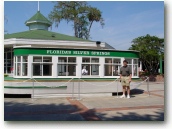 Silver Springs is located near Ocala, Florida, just 75 miles north of Orlando. Since the invention of its famous glass-bottom boats, millions of guests have come to Silver Springs to look into the depths of the seven major artesian spring formations at the head of the Silver River. The largest of the springs, Mammoth Spring, pumps 550 million gallons of water daily to create the headwaters of the Silver River, which flows northward for seven miles into the Ocklawaha River, the St. Johns River, and eventually to the Atlantic Ocean. The Silver River remains a constant 74 degrees, and its 99.8 percent pure water at the springs is home to a wide assortment of underwater and river bank life including alligators, turtles, gar fish, mullet, large mouth bass, heron and osprey. Silver Springs' attractive Botanical Gardens feature more than 138 varieties of native and exotic plants showcased
Silver Springs is located near Ocala, Florida, just 75 miles north of Orlando. Since the invention of its famous glass-bottom boats, millions of guests have come to Silver Springs to look into the depths of the seven major artesian spring formations at the head of the Silver River. The largest of the springs, Mammoth Spring, pumps 550 million gallons of water daily to create the headwaters of the Silver River, which flows northward for seven miles into the Ocklawaha River, the St. Johns River, and eventually to the Atlantic Ocean. The Silver River remains a constant 74 degrees, and its 99.8 percent pure water at the springs is home to a wide assortment of underwater and river bank life including alligators, turtles, gar fish, mullet, large mouth bass, heron and osprey. Silver Springs' attractive Botanical Gardens feature more than 138 varieties of native and exotic plants showcased
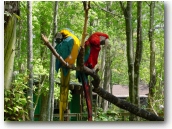 in floral sculptures and flower beds next to the Silver River. It is no wonder that this 350-acre treasure in north central Florida has been dubbed “Nature's Theme Park.”
in floral sculptures and flower beds next to the Silver River. It is no wonder that this 350-acre treasure in north central Florida has been dubbed “Nature's Theme Park.”
Throughout history, Silver Springs has been an environment of unparalleled natural beauty. As Harriet Beecher Stowe, the author of Uncle Tom's Cabin, described Silver Springs in 1873, "there is nothing on earth comparable to it". The area around Silver Springs was settled in the early 1500s by the Timucuan Indians, who called the area Ocali, a subprovince of Timucua. In 1539, Hernando de Soto and his conquistadors invaded the area in search of wealth. Despite several battles with the well-armed Spaniards, the Timucuan Indians managed to save their territory. Over time, other Indian tribes succeeded the Timucuans,
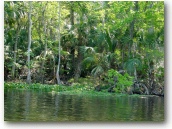 including the Seminoles. When the U.S. government attempted to move the Seminoles from Florida to western reservations in 1835, Chief Osceola and the Seminoles retreated to the southern swamps. Osceola's slashing of the peace treaty handed to him by government representatives became the famous gesture that gained him the respect and loyalty of the Seminole Indians, and many joined him in future battles.
including the Seminoles. When the U.S. government attempted to move the Seminoles from Florida to western reservations in 1835, Chief Osceola and the Seminoles retreated to the southern swamps. Osceola's slashing of the peace treaty handed to him by government representatives became the famous gesture that gained him the respect and loyalty of the Seminole Indians, and many joined him in future battles.
Commerce began in Silver Springs in the 1850s, as barges loaded with cotton, lumber and nonperishable goods travelled up the Silver River to supply the area's growing population.
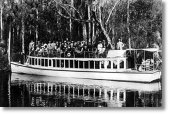 Hubbard H. Hart established the Hart Line, a stagecoach connection between Palatka, Silver Springs, Ocala and Tampa, and in 1860, hired James Burt who brought steamboats to Silver Springs. As a result, tourists flocked to the area by both stagecoach and steamboat to see the crystal-clear waters that had fascinated many for centuries. In 1878, Hullam Jones invented the glass-bottom boat and Silver Springs' popularity flourished. By installing a glass viewing box on the flat bottom of a dugout canoe, Jones created a window to an underwater world teeming with life. This primitive viewing box became the groundwork for Florida's first tourist attraction, the glass-bottom boats of Silver Springs.
Hubbard H. Hart established the Hart Line, a stagecoach connection between Palatka, Silver Springs, Ocala and Tampa, and in 1860, hired James Burt who brought steamboats to Silver Springs. As a result, tourists flocked to the area by both stagecoach and steamboat to see the crystal-clear waters that had fascinated many for centuries. In 1878, Hullam Jones invented the glass-bottom boat and Silver Springs' popularity flourished. By installing a glass viewing box on the flat bottom of a dugout canoe, Jones created a window to an underwater world teeming with life. This primitive viewing box became the groundwork for Florida's first tourist attraction, the glass-bottom boats of Silver Springs.
Beginning in the early 1900s, filmmakers realized the natural beauty of Silver Springs’ crystal-clear waters were ideal for creating underwater movie magic. The first film made at Silver Springs was The Seven Swans (1917), a silent movie starring Richard Barthelmess and Marguerite Clark. Many more films would follow, but it was not until the 1930s and 1940swith Metro-Goldwyn-Mayer's six Tarzan movies starring Johnny Weissmuller and Maureen O'Sullivan that Silver Springs' exotic surroundings became a popular location for films. In Walter Lang’s musical comedy Moon Over Miami (1941), Don Ameche and Betty Grable take a ride in a diving bell in Mammoth Spring, and glass-bottom boats are clearly visible in the background. The Silver Springs' sequence is seamlessly woven into scenes of Cypress Gardens, another location site used for this film. In Clarence Brown's screen adaptation of Marjorie Kinnan Rawling's sensitive tale of a boy attached to a young deer, The Yearling (1946) starring Gregory Peck and Jane Wyman, Silver Springs was filmed in exquisite Technicolor. In tribute to their outstanding work, an Oscar for Cinematography was awarded to Charles Rosher, Leonard Smith and Arthur Arling and for Art Direction for Cedric Gibbons and Paul Groesse. The film's newcomer, 12 year-old Claude Jarman, Jr., also won a special Academy Award for his portrayal of Jody Baxter.
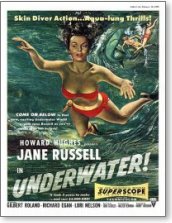 In the 1950s, Silver Springs appeared on the screen in Distant Drums (1951), Raoul Walsh's adventure story about Seminole Indians on the warpath in early 19th Century Florida that starred Gary Cooper as the stalwart swamp fighter. Silver Springs is also featured in Underwater! (1955), John Sturges' adventure story about deep sea diving for treasure, starring Jane Russell, Gilbert Roland and Richard Egan. Perhaps the best known entry from the 1950s is the archetypal monster movie cult classic Creature from the Black Lagoon (1954), starring Richard Carlson and Julia Adams. Originally in 3-D, the film's underwater swim
In the 1950s, Silver Springs appeared on the screen in Distant Drums (1951), Raoul Walsh's adventure story about Seminole Indians on the warpath in early 19th Century Florida that starred Gary Cooper as the stalwart swamp fighter. Silver Springs is also featured in Underwater! (1955), John Sturges' adventure story about deep sea diving for treasure, starring Jane Russell, Gilbert Roland and Richard Egan. Perhaps the best known entry from the 1950s is the archetypal monster movie cult classic Creature from the Black Lagoon (1954), starring Richard Carlson and Julia Adams. Originally in 3-D, the film's underwater swim
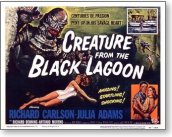 sequence of the Gill-Man and Kay Lawrence (Julia Adams) reveals the luminous, crystal-clear waters of Silver Springs. The Springs also appeared in Don't Give Up the Ship (1959), a lighthearted naval comedy starring Jerry Lewis and Dina Merrill, whose film crew left behind a sunken boat which can still be seen by taking the famous glass-bottom boat tour. In the decades that followed, several espionage spy flicks took advantage of this artesian oasis, including Blindfold (1965) starring Rock Hudson and Claudia Cardinale, and Never Say Never Again (1983) starring Sean Connery as 007 in the remake of fourth James Bond film, Thunderball (1965).
sequence of the Gill-Man and Kay Lawrence (Julia Adams) reveals the luminous, crystal-clear waters of Silver Springs. The Springs also appeared in Don't Give Up the Ship (1959), a lighthearted naval comedy starring Jerry Lewis and Dina Merrill, whose film crew left behind a sunken boat which can still be seen by taking the famous glass-bottom boat tour. In the decades that followed, several espionage spy flicks took advantage of this artesian oasis, including Blindfold (1965) starring Rock Hudson and Claudia Cardinale, and Never Say Never Again (1983) starring Sean Connery as 007 in the remake of fourth James Bond film, Thunderball (1965).
In addition to appearing on the big screen, Silver Springs has also been a favorite locale for hundreds of television shows including The Jack Paar Show, You Asked For
It, I Spy, Mutual of Omaha's Wild Kingdom, SeaQuest and even the soap opera One Life To Live. The most notable television show to use this locale was Sea Hunt starring Lloyd Bridges as Mike Nelson, with more than 100 episodes being filmed there. Television specials for National Geographic and The Discovery Channel have also been filmed at Silver Springs, as well as commercials for Mercury Motors, Johnson & Johnson, Dupont, and Dean Witter. Military training films on jungle warfare have also been shot at the park.
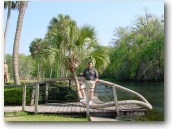 Silver Springs is open 10:00 AM until 5:00 PM every day of the year. In addition to the must-see glass-bottom boats, the many attractions that visitors can enjoy include the Fort King River Cruise, Lost River Voyage, Jeep Safari, World of Bears, Panther Prowl, Big Gator Lagoon, Alligator & Crocodile Encounter, Sobek, Kids Ahoy! Playland, Doolittle's Petting Zoo, and the Botanical Gardens, as well as an assortment of educational programs such as Reptiles of the World, Creature Feature, Florida Natives Exhibit, Birds of Prey and Birds of the Rainforest. Another extremely popular attraction is the Saturday afternoon Concert Series highlighting nationally-known artists that are currently performing at the Twin Oaks Mansion. As a location site for both the film and television industry, Silver Springs continues to showcase its beautiful crystal-clear waters, tropical jungles and thick forests.
Silver Springs is open 10:00 AM until 5:00 PM every day of the year. In addition to the must-see glass-bottom boats, the many attractions that visitors can enjoy include the Fort King River Cruise, Lost River Voyage, Jeep Safari, World of Bears, Panther Prowl, Big Gator Lagoon, Alligator & Crocodile Encounter, Sobek, Kids Ahoy! Playland, Doolittle's Petting Zoo, and the Botanical Gardens, as well as an assortment of educational programs such as Reptiles of the World, Creature Feature, Florida Natives Exhibit, Birds of Prey and Birds of the Rainforest. Another extremely popular attraction is the Saturday afternoon Concert Series highlighting nationally-known artists that are currently performing at the Twin Oaks Mansion. As a location site for both the film and television industry, Silver Springs continues to showcase its beautiful crystal-clear waters, tropical jungles and thick forests.